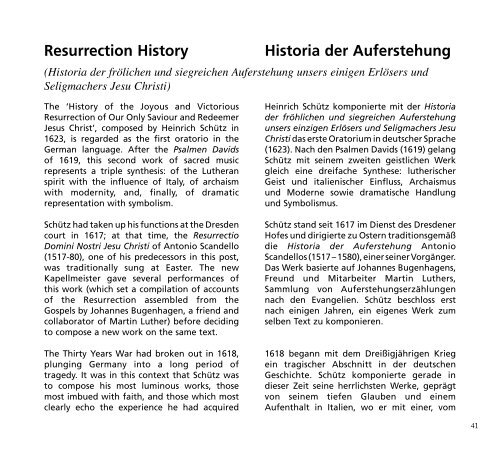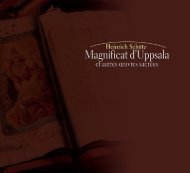Histoire de la Résurrection & Musikalische Exequien - La Chapelle ...
Histoire de la Résurrection & Musikalische Exequien - La Chapelle ...
Histoire de la Résurrection & Musikalische Exequien - La Chapelle ...
Create successful ePaper yourself
Turn your PDF publications into a flip-book with our unique Google optimized e-Paper software.
Resurrection History<br />
The ‘History of the Joyous and Victorious<br />
Resurrection of Our Only Saviour and Re<strong>de</strong>emer<br />
Jesus Christ’, composed by Heinrich Schütz in<br />
1623, is regar<strong>de</strong>d as the first oratorio in the<br />
German <strong>la</strong>nguage. After the Psalmen Davids<br />
of 1619, this second work of sacred music<br />
represents a triple synthesis: of the Lutheran<br />
spirit with the influence of Italy, of archaism<br />
with mo<strong>de</strong>rnity, and, finally, of dramatic<br />
representation with symbolism.<br />
Schütz had taken up his functions at the Dres<strong>de</strong>n<br />
court in 1617; at that time, the Resurrectio<br />
Domini Nostri Jesu Christi of Antonio Scan<strong>de</strong>llo<br />
(1517-80), one of his pre<strong>de</strong>cessors in this post,<br />
was traditionally sung at Easter. The new<br />
Kapellmeister gave several performances of<br />
this work (which set a compi<strong>la</strong>tion of accounts<br />
of the Resurrection assembled from the<br />
Gospels by Johannes Bugenhagen, a friend and<br />
col<strong>la</strong>borator of Martin Luther) before <strong>de</strong>ciding<br />
to compose a new work on the same text.<br />
The Thirty Years War had broken out in 1618,<br />
plunging Germany into a long period of<br />
tragedy. It was in this context that Schütz was<br />
to compose his most luminous works, those<br />
most imbued with faith, and those which most<br />
clearly echo the experience he had acquired<br />
Historia <strong>de</strong>r Auferstehung<br />
(Historia <strong>de</strong>r frölichen und siegreichen Auferstehung unsers einigen Erlösers und<br />
Seligmachers Jesu Christi)<br />
Heinrich Schütz komponierte mit <strong>de</strong>r Historia<br />
<strong>de</strong>r fröhlichen und siegreichen Auferstehung<br />
unsers einzigen Erlösers und Seligmachers Jesu<br />
Christi das erste Oratorium in <strong>de</strong>utscher Sprache<br />
(1623). Nach <strong>de</strong>n Psalmen Davids (1619) ge<strong>la</strong>ng<br />
Schütz mit seinem zweiten geistlichen Werk<br />
gleich eine dreifache Synthese: lutherischer<br />
Geist und italienischer Einfluss, Archaismus<br />
und Mo<strong>de</strong>rne sowie dramatische Handlung<br />
und Symbolismus.<br />
Schütz stand seit 1617 im Dienst <strong>de</strong>s Dres<strong>de</strong>ner<br />
Hofes und dirigierte zu Ostern traditionsgemäß<br />
die Historia <strong>de</strong>r Auferstehung Antonio<br />
Scan<strong>de</strong>llos (1517 – 1580), einer seiner Vorgänger.<br />
Das Werk basierte auf Johannes Bugenhagens,<br />
Freund und Mitarbeiter Martin Luthers,<br />
Sammlung von Auferstehungserzählungen<br />
nach <strong>de</strong>n Evangelien. Schütz beschloss erst<br />
nach einigen Jahren, ein eigenes Werk zum<br />
selben Text zu komponieren.<br />
1618 begann mit <strong>de</strong>m Dreißigjährigen Krieg<br />
ein tragischer Abschnitt in <strong>de</strong>r <strong>de</strong>utschen<br />
Geschichte. Schütz komponierte gera<strong>de</strong> in<br />
dieser Zeit seine herrlichsten Werke, geprägt<br />
von seinem tiefen G<strong>la</strong>uben und einem<br />
Aufenthalt in Italien, wo er mit einer, vom<br />
41



